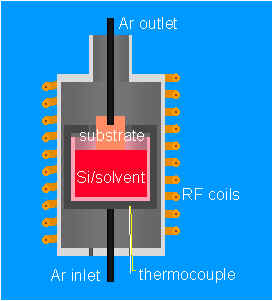We
developed a thin-layer Si growth method with large grain size and high
Si film quality based on vertical dipping liquid phase epitaxy (LPE). See
top figure. Cu/Al solvent was shown to provide
native oxide removal, good nucleation, impurity/dopant gettering, smooth isotropic growth
on different grains of an MG-Si substrate (see middle figure), and rapid growth.
The P-type resistivity
could be adjusted between 0.01-0.2
Ω.cm by using various Cu/Al ratios to modify the uptake
of Al. Cu concentrations in the Si film are
<1x1016 cm-3 -
less than the cell degradation onset. LPE Si layers grown from Cu on single crystal
substrates do not substantially degrade
solar cell efficiency (see bottom figure).
A growth rate ~ 1
μm/min
was used for temperatures of 850-950 C. 30-μm-thick LPE-grown
layers on MG-Si had 4.5
μs
lifetime.
Improvements in substrate quality
are necessary for epi-layer quality consistency and efficient PV cells. SiC
particles in the MG-Si substrate can act as shunts in the solar cell.
_______________
Theodore F. Ciszek and Tihu Wang,
"Crystallization from High Temperature Solutions of Si in Cu/Al Solvent," U.S.
Patent 5,544,616 (1996).
T.H. Wang, T.F. Ciszek, C.R. Schwerdtfeger, H.
Moutinho, and R. Matson, "Growth of silicon thin layers on cast MG-Si from metal
solution for solar cells," Solar Energy Mat. and Solar Cells 41/42, (1996) pp.
19-30.
|
 |